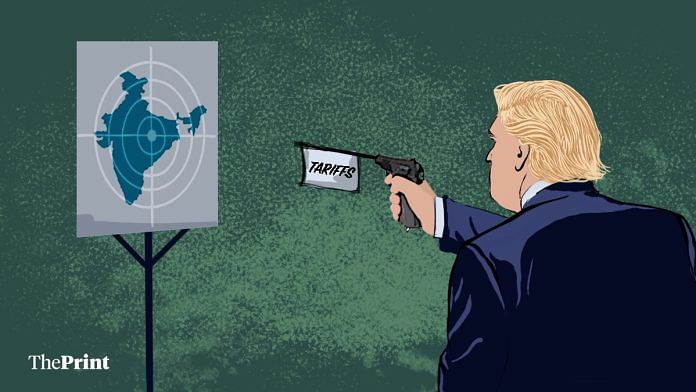Punitive tariffs imposed by the US on India will hurt. Yet two truths stand out. First, India cannot afford to forsake or even downplay globalisation, as some have suggested. Second, the policy responses needed to mitigate the damage are the very reforms that India should be pursuing, regardless of the tariffs.
Since “Liberation Day” tariffs were announced by President Donald Trump in April 2025, US tariffs have become a moving target. As of 1 August, India faces “reciprocal tariffs” of 25 per cent and, from 27 August onwards, an additional penal tariff of 25 per cent. We estimate that as a result of these tariffs, India’s annual exports to the US – currently almost a fifth of the country’s goods exports – could decline by $19 billion to $35 billion. Some labour-intensive sectors, such as textiles and apparel, diamonds, and shrimps, would be especially vulnerable.
A silver lining in the US tariff imposition is that services have not been included, at least so far. India’s services exports are showing greater dynamism than goods exports; in FY25 their value was 89 per cent of goods exports. Thus, services will remain a strong anchor for India’s overall export performance. But the bigger lesson goes beyond the short-term hit: the tariffs underscore, once again, India’s dual challenge – embracing globalisation more fully, and accelerating long-debated reforms.
On globalisation, India is still a lower middle-income country. Sustained growth and the goal of Viksit Bharat 2047 requires India to leverage the global economy in its entirety, embracing the upsides and managing the downsides. Yet India’s high tariffs, frequently called out by Trump, reflect India’s ambivalence about full engagement with world markets.
Policymakers should remember that India’s best growth years were accompanied by dynamic export performance. Exports enable companies to expand beyond the domestic market (mobile phones being a case in point), and enjoy competition-driven productivity growth. Imports provide cheaper products and inputs, and enable technology upgrading.
Finally, note that all the high-performing East Asian economies have achieved much higher peak trade-to-GDP ratios than India, whose 2024 ratio of 45 per cent stands far below its own peak 2012 trade ratio of 56 per cent.
Also read: Tiruppur orders on hold, pressure to sell cheap, Diwali fears—Trump tariff & Tamil Nadu hub
Reforms India must push for
This brings us to reforms, without which India cannot fully benefit from globalisation. The agenda is not new, but the urgency is greater than ever. In a recent CSEP Working Paper, co-authored with Prerna Prabhakar, we proposed a core agenda for revitalising manufacturing competitiveness. This includes:
1) Rationalising India’s tariff structure to better align with East Asian competitors. Current high tariffs raise input costs and bias firms towards the domestic market. According to the latest WTO data, the simple average tariff in 2024 on all products was 7.5 per cent for China, 16.2 per cent for India, and 9.5 per cent for Vietnam.
2) Hastening the completion of free trade agreements (FTAs) with the EU, and deepening existing ones with ASEAN, Japan, and South Korea. Unlike its Asian peers, India is not part of any mega-regional trading bloc. New and deeper FTAs will help diversify markets and reduce dependence on a single market. China provides a striking example: in the wake of the US-China trade war, it increased total exports by more than a trillion dollars, even as the US’ share in its export basket fell from about 20 per cent to 10 per cent over the past six years.
3) Enhancing the quality of regulations that impede firm growth, complicate land acquisition, and inhibit efficient urbanisation. Labour laws, for example, create a disincentive for firms to grow, creating a very lopsided industrial structure, wherein medium and small enterprises form 96 per cent of industrial units in India.
4) Fostering technological development through a holistic approach that recognises the core role of competition in spurring research, adaptation and innovation. Moving from lower-middle-income to high-income status will require increasing innovation to accompany investment and technology diffusion. India invests just 0.6 per cent of GDP on R&D, compared with 2.4 per cent in China and 1.2 per cent in Thailand.
Dire economic prognoses – and crises in particular – often provide the political space for difficult reforms. India should use the current trade upheaval to push through some crucial reforms, while also managing the short-term fallout of lost or cancelled orders.
The current scenario is by no means all doom and gloom. Even if punitive US tariffs persist and exports to the US take a sizeable hit, services exports remain buoyant. Goods exports can find alternative destinations, and India has some fiscal space to provide targeted support for this process. Trade and economic partnerships can also be widened. Most importantly, domestic reforms – which will have a much bigger long-term impact on India’s exports and overall growth – can be accelerated.
India can convert the tariff turmoil into an opportunity to position itself as the world’s go-to trade partner. It has the scale and heft to back this ambition — all it needs is the boldness to embrace it.
Sanjay Kathuria is co-founder of the Trade Sentinel, a visiting senior fellow at the Centre for Social and Economic Progress, visiting professor at Ashoka University, and nonresident senior fellow at the Institute of South Asian Studies. His X handle is @Sanjay_1818.
TG Srinivasan is co-founder of the Trade Sentinel, and visiting senior fellow at the Centre for Social and Economic Progress. His X handle is @tgsv.
Views are personal.
(Edited by Prashant)
Also read: Thank you Trump for putting tariff gun to India’s head. That’s the only way we’d be forced to reform







I don’t see any hope for poor, corrupt, socialist Republic of India.